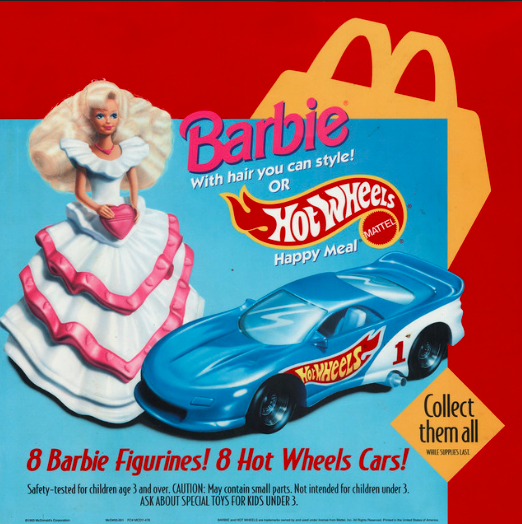
The emergence of the McDonald’s Adult happy meal has brought up numerous comments on the appearance of the toys. While the toys represent the original beloved characters, though unpleasant, this commentary echoes a much larger debate on the push of gender bias in McDonald’s toys.
Undoubtedly, those of us who lived off McDonald’s as children remember the workers asking about the gender of the kids or making assumptions about the performance of the gender they saw. Little girls had malibu barbies and ponies, while boys received trucks and Star Wars memorabilia.
In the lens of Gender studies, this is a prime example of how women’s subordinate role is sustained through American culture. More specifically, if women are associated with danger, uncontrollable bodies, and emotions, then the images we publicize must justify that a silent, submissive, and beautiful woman is what we must model ourselves after.
For example, Barbie, the hallmark toy for girls, represents no intersectionality of race and gender, has an abnormal accentuation of the ideal body, and overly feminizes the few non-traditional professions she has with glitter and pink sparkles. The perspective of Gender Studies pulls into question all the ways corporations instilled femininity and masculinity in our childhoods.

I really enjoyed this analysis of gender and the role it plays in branding, especially aimed toward children. There are very explicit messages everyone gets as children, designed to mold people into their assigned gender roles. I also really admired the appearance of your post, the color blocks matched with the colors in the ad are really visually engaging!
I really liked how you analyzed how marketing and branding of products were affected by gender roles. I also liked how you brought into focus how branding of products would be percieved through the perspective of Gender Studies.
I don’t think it’s necessarily wrong to let girls play with doll toys, and a mature, independent woman who remembers playing with dolls as a child doesn’t have to feel ashamed. The problem is, compared to those “toys for boys”, those “toys for girls” in the form of too single. It seems to encourage boys to discover and innovate, but constantly restricts girls. I hope that in the future, when “toys for girls” are mentioned, Barbie is not the only thing that comes to mind.
This reminded me of walking through a target a couple of months ago. I was actually surprised that there were so many more options on the shelves compared to when I was younger. Although the standard is still typically white and thin, I think it’s a great stride compared to where we were (there can always be improvements and more representation).
Heres a link to some of the new dolls that barbie has added: https://www.parents.com/news/the-barbie-fashionistas-line-doll-with-prosthetic-leg-vitiligo-behind-the-ear-hearing-aids/
I remember the countless times I would hear “do you want a girl toy or a boy toy” from the tinny McDonald’s speaker box as a child. This is a good analysis of the gender roles these toys reinforce. However, like Rae, I would also like to point out that Barbie is now trying to incorporate women of different races and body types into their doll designs, which doesn’t undo the damage they have done in the past but is nevertheless fantastic.
I will always remember waiting to see what toy was in my Happy Meal box and I also remember questioning, even as a kid, why the girls didn’t get the Star Wars toys as well. I really liked how you formatted this and I think you made some really great points that so many people, including myself, agree with.